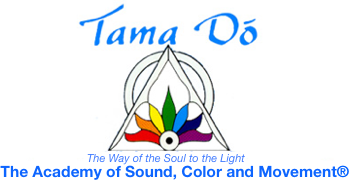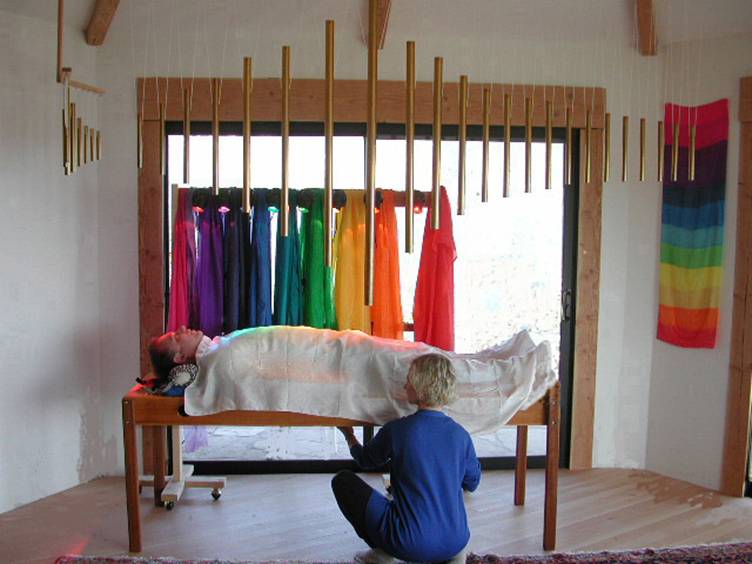

Fabien Maman, the founding father of vibrational sound therapy, created a wonderful technique called T.E.P. (Tama-Do Extra Points), which balances the chakras and subtle energy fields using Chi on the etheric (physical) body, sound in the astral (emotional) body, and color on the mental subtle body. Each session creates a whirlpool of energy, allowing deep transformation.
In the beginning, Fabien Maman used Tibetan bowls to balance the chakras, but he found them not very practical, and not in pitch.
He had a dream where long sound tubes were hanging over the body, so that he could use both his hands for his TEP technique. He designed beautiful Chakra Sound Tubes®, made from the finest quality of instrument-grade brass.
In the picture above, you can see our full rack of TEP Chakra Sound Tubes® (32 tubes).
The Tama-Do Chakra Sound Tubes® includes three different scales:
The TEP Cycle of Fifths for the Chakras® consist of 8 sound tubes with the note for the root chakra and progressing up to the crown.
The fifth interval between notes is the most empowering and expanding of all notes in Classical music tradition. It is also one of the most important factors of expansion in sacred geometry. The pentagram is the fundamental model for the human being.
The scale of resonance works perfectly to stimulate the chakra energies and expand one’s consciousness toward the sky.
This scale takes five octaves to play in the correct order. Crystal bowl and Tibetan bowl dealers are not pleased with Fabien Maman's research. It is extremely difficult to find bowls that match these exact pitches, let alone five octaves! The Ionian (diatonic) scale is much easier for business!
F (Root) - C (Tantien) - G (Solar Plexus) - D (Heart) - A (Throat) - E (3rd Eye) - B (Crown) - F# (Bindu)
Track 12 Tama-Do Chakra Sound Tubes for the TEP ~ Cycle of Fifths for the Chakras® (P.197 The Tao of Sound):
Fabien Maman developed the F Overtone Scale for the Chakras® to ground the Root Chakra. Studies have shown that low F is the vibrational frequency of the circumference of the earth.
With 15 sound tubes, the F Overtone Scale for the Chakras® works to stretch the energy from the first chakra down to the earth, as it expands consciousness in the energy field.
Fabien Maman uses 15 notes, even though the overtone scales go on forever!
F C F A C D# F G A B C D D# E F
Track 13 Tama-Do Chakra Sound Tubes for the TEP ~ F overtone scale for the Chakras® (P.197 - The Tao of Sound):
Fabien Maman developed the E Overtone Scale for the Chakras® to clear the energy around the head, opening the third eye, crown chakra and Bindu.
With 9 sound tubes, the E Overtone Scale for the Chakras® re-harmonizes in a very fine way the first 3 auras of the head.
Fabien Maman uses 11 notes, even though he could go on forever to the sky!
E B E G# B D E F# G# A# B
Track 14 Tama-Do Chakra Sound Tubes for the TEP ~ E overtone scale for the Chakras® (P.197 - The Tao of Sound):
In the early 80s, before he conducted his famous sound/cellular research on human cells, Fabien Maman, the founding father of vibrational sound therapy, developed the now famous system of using "The Cycle of Fifths" (starting with low F) instead of a diatonic scale (C,D,E etc) to empower and energize the chakras.
The following is an excerpt taken from The Tao of Sound - Acoustic Sound Healing for the 21st Century by Fabien Maman and Terres Unsoeld © Tama-Do Academy 2010
by Fabien Maman
"For a long time, different traditions have been looking for sound correspondences to the chakras. I experimented with several of these models but was not satisfied with the results.
I was particularly surprised by the popularity of the Ionian Mode (C-D-E-F-G-A-B-C on the piano within one octave)! This simplistic correspondence has no foundation. No one ever sat at a piano and tried it ! When I played the C, it did not feel like the energy of the root chakra at all.
To play a C to a D is a second interval, the most dissonant of intervals! Because I had used a sequence of second intervals to explode cancer cells in my sound/cellular research, I could not imagine how such a sequence could open the chakras!
Listen to the Cycle of Fifths on the Piano:
Track 9 Cycle of Fifths for the Chakras® by Fabien Maman (Piano) (P.178 - The Tao of Sound):
Now listen to the Ionian mode on the Piano:
Track 19 Ionian Mode (P.233 - The Tao of Sound):
Which would you prefer to open your chakras?
I played around on the piano, and found that the F2 (the 2nd F from the left on a piano) resonated quite nicely with my root chakra, which is connected with the element Earth.
French physicist Joel Sternheimer corroborated my finding by telling me that quantum physicists consider F/F# as the vibrational frequency of the circumference of the Earth. In Chinese medicine, their central note: “Koung” is also an F and is associated with the Earth element. This made perfect sense to me.
So where did the idea of C come from for the root chakra?
How could so many people be so wrong?
The only logic I could find was that the erroneous chakra notes originated from a misinterpretation by a westerner who observed a sitar player in India at the beginning of the 20th century.. Indian ragas are usually tuned to the key of C or C#. When a sitar player sits on the floor in lotus, his sitar sits in his lap. Because he is sitting on his coccyx on the earth, one can see how someone mistakenly decided that C must be the note of the root chakra.
In reality, when the sitar plays his instrument, the calabasse of the sitar is sitting in his lap and pressing against his tantien, which corresponds to the second chakra. The C is vibrating the second chakra, not the first.
Once someone with a simplistic mind who did not do his research made the wrongful decision that C was the root chakra, it was easy to slide to the Ionian scale, which begins with C. The next note is D, which is commonly thought of as the second chakra.
From this mistake, generations copied this erroneous scale, and here we are today, with thousands of sound practitioners mixing up their chakras with a cycle of seconds, the most dissonant of all notes, rather than a Cycle of Fifths!
In the early 90s, when I first moved to the United States, I met with an elite group of sound healing pioneers and shared with them my sound research and my chakra correspondences.
Although they agreed with me wholeheartedly that the Cycle of Fifths was by far superior to the Ionian mode, they said they could not change their public stance on the matter, as their CDs and books had already been published.
But they still wanted to remain my friend!
Shopping Policy - Shipping - Returns and Cancellations - Terms and Conditions - Privacy
© Tama-Do Academy - All Rights Reserved.
top of page navigation
Please contact us for registration and additional information:
In the United States:
Telephone: 310-774-1307
Fax: 310-456-5664
or Email: info@tama-do.com
Outside the United States:
Email: tamadoacademy@aol.com
Tama-Do Academy is an international school with its home based in the United States of America. We follow all law under the United States jurisdiction. In cases of dispute, it is the English website which the Academy adheres to and finds binding, for all current protocols, rules and procedures of the Academy, and from which all other translated pages (French, Spanish and German) must follow.